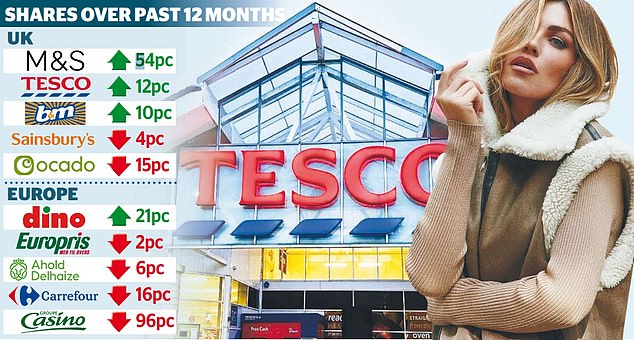The search for smart clothing and investment research can go hand in hand, or so I have learned, and lately I have been locating a decent number of gems in Tesco’s F&F fashion range.
These finds have coincided with ‘buy’ recommendations for Tesco shares from investment banks Goldman Sachs, UBS and other major names, making me think that this £19.35billion supermarket chain merits a place in my portfolio.
Like Marks & Spencer, Tesco is resurgent, a traditional player adapting to cater for those who shop online, but also for those who like the convenience and social experience of buying in a bricks and mortar store.
To speed this evolution, Tesco can rely on its strengths in data and technology, making the most not only of its loyalty card scheme Clubcard, but also its analytics arm Dunnhumby. Thanks to these operations, Chris Beckett, Quilter Cheviot’s head of equity research, argues that ‘the company is ready to navigate changing competitive and market dynamics’.
Against this backdrop, US giant Morgan Stanley has rated Tesco as the top European retail stock, in a verdict that came before Tesco’s £600m sale of its banking business to Barclays last week. This deal was declared to be ‘an outstanding outcome’ by Clive Black, of Shore Capital. He also rates Tesco as a ‘buy’.

These positive assessments may provoke a jaundiced response among Tesco’s long-term investors. The shares have risen by 14 per cent over the past 12 months to 275p, as food price inflation has lessened. Yet they remain 32 per cent lower than at the start of 2014 when Tesco became engulfed in an accounting scandal, arising from the revelation that profits had been overstated.
Such was the severity of the affair that it posed an existential threat to the 105-year-old firm, which found itself investigated by the Serious Fraud Office and the Financial Conduct Authority.
However, the crisis did force the reshaping of the business. The debt mountain was reduced and subsidiaries, such as the Harris & Hoole coffee shops, were sold.
Tesco’s readiness to sustain this process of transformation is one of the reasons why I will be buying the shares.
‘Tesco is now in the best position it has been in for over a decade,’ according to David Smith, of Henderson High Income Trust, which has a stake in the supermarket. ‘It has robust trading momentum – and should be able to deliver decent profit growth.’
The agreement to sell the bank should accelerate Tesco’s return to its core business.
Tesco has a 27.2 per cent share of the UK grocery market, almost twice that of Sainsbury’s. It also has stores in the Czech Republic, Hungary and Slovakia, and owns the food wholesaler Booker.
But size is not Tesco’s only advantage. The German discounters Aldi and Lidl represent a constant challenge. Yet two other big rivals are in disarray. Asda is struggling with substantial borrowings and debt is a massive challenge at Morrisons.
Meanwhile, Tesco is benefiting from its Aldi price-matching campaign which, tacitly, acknowledges that the discounter has become the sector’s price-setter.
Another spur to progress is the discounts for Tesco’s 20m Clubcard holders, although this two-tier pricing arrangement is being probed by the Competition and Markets Authority (CMA).
But Tesco does not only concentrate on being cheap. Its Finest range caters for the ‘considered consumption’ trend, in which shoppers largely spend cautiously, but also treat themselves.
During the 19 weeks to January 6, there was a 17 per cent increase in sales of Finest products, one of the factors that enabled Tesco to have its best-ever Christmas, with sales up by 6.4 per cent.
Announcing these figures, boss Ken Murphy said full-year profits were expected to be about £2.75billion, against £2.6-£2.7billion. This should produce what he called ‘strong retail free cash flow generation of around £2billion’.
Free cash flow is the money left over after funding the upkeep of capital assets and paying expenses, which should ensure that Tesco’s 4.1 per cent dividend yield is maintained.
For me, this yield is one of the strongest reasons to put some money into Tesco shares. Such is the competitiveness of the grocery sector that expansion is difficult.
The dividends – and the share buybacks – have made Tesco a popular share at such UK equity income trusts as City of London, Diverse Income, Edinburgh, Merchants and Witan.
In November 2022, I invested in M&S on the basis that I liked the clothes and the make-over. The results have been gratifying. I am hoping that Tesco will make itself equally popular with me.
Some links in this article may be affiliate links. If you click on them we may earn a small commission. That helps us fund This Is Money, and keep it free to use. We do not write articles to promote products. We do not allow any commercial relationship to affect our editorial independence.



